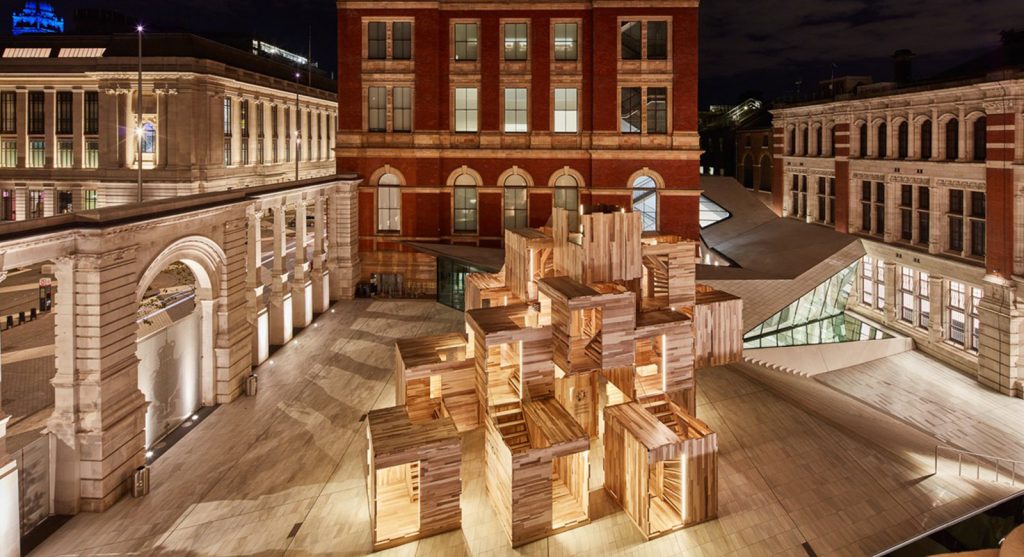

HAVING CARVED A NICHE AS AN INNOVATOR IN ENGINEERED TIMBER, LONDON PRACTICE WAUGH THISTLETON ARCHITECTS (WTA) CONTINUES TO RESEARCH AND PROMOTE CLT’S UNIQUE PROPERTIES. BELINDA SMART CAUGHT UP WITH CO-FOUNDER ANDREW WAUGH AT THE COMPANY’S SHOREDITCH BASE EARLIER THIS YEAR.
As this issue of Built Offsite went to press, a London practice that punches well above its weight had just secured the go-ahead for a project that embodies the conjunction of social equity, sustainability and innovation at its foundations. Waugh Thistleton Architects’ design for the regeneration of the Kennaway Estate has won London Borough of Hackney approval. The project will deliver just over 60 new homes as well as a new workspace and community centre, it will also favour pedestrian routes, play spaces, cycle storage facilities and other amenities.
This is the kind of socially conscious and considered work for which the practice is known. But WTA’s reputation stems as much from innovation in materials and methodology as it does from creating enhanced urban spaces.
Speaking to Built Offsite, WTA co-founder Andrew Waugh confirmed the company completed its first CLT building 16 years ago, before going on in 2008 to achieve renown for the first tall timber building in the world – a residential block totalling 33 metres in height and housing 29 units.
“That really was a major attention-grabber internationally for what could be done in timber,” says Waugh. “Before that people were building three or four stories in CLT, but nobody had done anything more than that. We had completed some buildings in CLT, but on a small scale, by that time, but we’d begun to understand how CLT affected architecture. I think for us, high density urban housing is really the architectural issue of our age. So, how can we do that without exacerbating climate change, without emitting more carbon into the atmosphere? That is the conundrum for contemporary architects.”
“…we’d begun to understand how CLT affected architecture. I think for us, high density urban housing is really the architectural issue of our age. So, how can we do that without exacerbating climate change, without emitting more carbon into the atmosphere? That is the conundrum for contemporary architects.”
Andrew Waugh, co-founder – Waugh Thistleton Architects.

WTA has led the way in mining the benefits of engineered timber to help solve that conundrum, and continues to evolve its methodology. The company maintains strong relationships with European plants primarily in Austria, as well as Germany and Scandinavia, to source its materials. “We work with large scale, cross laminated timber panels as the primary structure. They are typically 12 by three metres, mainly so they can fit through the channel tunnel. From our drawings, a BIM software file goes through to the manufacturer and they cut the windows out, the doors out, the profiles out. The elements of the building arrive on site; like an Airfix model [scale model aircraft kit], and then we crane it into place and screw it together.”
Notable recent projects include modular housing scheme Watts Grove in central London (for housing association Swan Housing). Built over seven storeys, it comprises 65 homes, with a program of just under 10 months from start to completion at the end of 2019.
“That’s an exciting scheme because it’s all made of solid timber,” says Waugh. “It’s such a fast, efficient means of producing modular housing; it’s also high quality and incredibly robust. With high density housing, you need to be confident that the acoustics and thermal insulation are going to be really efficient, so the homes are low maintenance, the heating bills aren’t high, and so tenants aren’t driven mad because they can hear people above and below and either side in terms of the acoustics.”
Other projects include another CLT social housing scheme, also seven storeys, and a taller social housing scheme. A unifying principle across these projects is to change perceptions around factory produced housing, says Waugh. “It’s important to realise that it doesn’t have to result in the same box again and again. What we’re trying to do is to demonstrate that we can run a factory process, where the product is really different whenever we need it to be, so that if the context and the client brief of the building changes, then the product changes to suit the client and the context.”
“It’s important to realise that it doesn’t have to be the same box again and again. What we’re trying to do is to demonstrate that we can run a factory process, where the product is really different whenever we need it to be, so that if the context and the client brief of the building changes, then the product changes to suit the client and the context.”
Andrew Waugh, co-founder – Waugh Thistleton Architects.
“This is where CLT works really well, because if you have a single panel of CLT going through a machine, you can do that every time the panel goes through, it’s exactly the same part of the factory process; but the cutting diagram that goes into that can be completely different, so you get repeated processes but a different product. If you’re making it out of ‘sticks’, then every time you want to change something, you have to change all the different ways those sticks are assembled; so it’s much more complex.”
Building on its foundation in panelised solutions, WTA moved into the volumetric space around three years ago and now utilises a combination of volumetric and panelised solutions as the optimal way to work.
Research is a central element of WTA’s approach, from structural research to research into the behaviour of different types of timber. “Among other things we’re looking at working with different types of adhesives, with different types of hardwood and softwood mixes.” This focus on innovation is aided by nimble practice culture. “We took an active decision not to get too big, which means I’m able to be involved with each individual in the practice and the projects they’re working on.”
A number of modular housing factories in the UK are now working in timber and Waugh says offsite and CLT are gaining traction in the market. “Steel and concrete are contributing to an increasingly visible issue in terms of carbon emissions, so I see wider use of mass timber construction as inevitable.”
Meanwhile WTA continues to widen its scope. “We’ve even looked at a couple of projects in Australia but the truth is that for an office in London to work in Australia, the project has to be at a certain scale. We’re just starting work of that level in Europe, so who knows where the next few years could take us.”

“We’ve got good friends in Australia; DesignMake at Lendlease is one of them. The way they’ve taken hold of the opportunities engineered timber can provide is really exciting.”
Challenges in the UK that would also be recognised in Australia, he says, include pipeline and scale. “Offsite requires a relatively large investment; you need a very willing market, whereas actually what you have in construction is often a very conservative market. So it’s not an easy thing to do these days.”
“In terms of Australia’s advantages, I see it as a very dynamic culture. In the UK, we’re great at innovating and terrible at commercialising and while the same is sometimes said about Australia, I really do think Australia’s culture is: if you see something that works, then you go for it.”■
“In terms of Australia’s advantages, I see it as a very dynamic culture. In the UK, we’re great at innovating and terrible at commercialising and while the same thing is sometimes said about Australia, I really do think Australia’s culture is: if you see something that works, then you go for it.”
Andrew Waugh, co-founder – Waugh Thistleton Architects.
